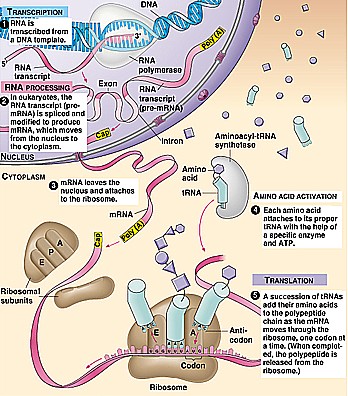Agenda
- Notes
- Lab 37 work
- Review:
- DNA --> RNA -->Protein
- Genes determine protein which makes up your appearance and cell capabilities
- Change in nucleotide sequence of DNA:
b. Base insertions or deletions - adding or subtracting nucleotides. Often results in disaster- can disrupt entire sequence of triplet pairings.
- Mutagens - physical and chemical agents, such as UV light, X Rays, chemicals, carcinogens. These CAN cause mutations. They can also lead to diversity. DNA errors can also be due to unknown causes.

Lab info.
- DNA has two strands, one will have a base sequence.
- In the process of transcription, a strand of messenger RNA is transcribed with a sequence complimentary to the base sequence of the DNA. (this happens in the nucleus, DNA does not leave the nucleus, RNA does) **Remember RNA has U instead of T-- Uracil instead of Thymine**
- During translation, codons, or sequences of nucleotides, form a code that specifies the order that amino acids, the "building blocks of protein", should be linked in a protein. Transfer RNA bring amino acids into place to be linked together with the according codons. In this process. the code in the messenger RNA, is translated into a special sequence of amino acids.(This all takes place attached on a ribosome in the cytoplasm)
- When the ribosome is attached to the messenger RNA, transfer RNA carrying it's specific amino acid molecule, temporarily attached to the messenger RNA at its codon. Then, a transfer RNA molecule complimentary to the adjacent messenger RNA temporarily attaches to it. The ribosome then moves to that point of attachment on the messenger RNA. During each of those attachments, peptide bonds formed between the amino acids. And the transfer RNA molecules become free from the amino acids and RNA, and they can attach to another molecule of it's specific amino acid and carry it to another point along the messenger RNA. This is a growing chain that continues as ribosomes move along messenger RNA, as amino acids are added.
- This pattern does not end until a termination codon is encountored. This gives the code for the translation to stop.

Homework
- Finish lab 37
- Do UP pages 99-110
- Work on Tribune project (Due: 12/7)
NEXT SCRIBE: Kristen
No comments:
Post a Comment